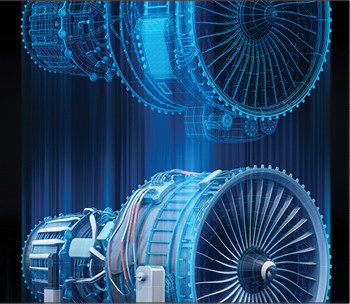The Future, Brought to You by Virtual Twins

Tomorrow’s manufacturing will require faster innovation, along with more complex models and operational processes.
By Eric Green
The 2010s saw a new wave of fast-changing disruptive technologies that impacted society and reshaped the manufacturing landscape. In many ways, the next 10 years will also present a drastic difference. Now, in the thick of technology evolutions within AI, machine learning, IoT, optimization, and digital twins, advancements are predicted to only accelerate. In fact, a combination of these technologies is already taking shape to form the driver for the next generation of innovation: The Virtual Twin Experience. Expanding upon the technology of the digital twin, it employs virtual modelling, simulation, and optimization capabilities that will enable companies to more easily introduce new manufacturing models and operational processes and create new products at an unprecedented rate.
With this progression comes increasing complexity that will likely result in greater forms of disruption, but also opportunities. Let’s envision what 2030 will hold for the future of manufacturing.
Changes in Technology, Operations, and Market Response
The COVID-19 crisis demonstrated that we still have a ways to go in recovering from and anticipating major changes. Indeed, the technologies that exist and aid us now have never been more powerful, but they can only get better from here. Like current manufacturing, future advancements will comprise both automation and workers but on a very different scale. Technologies with enhanced sophistication and automation not yet available today will be further driven through data and sensors to operate at a level of synchronization that ensures significantly diminished waste and inefficiencies.
Different sets of technologies will be integrated to form an ecosystem for improved process management, manifesting into virtual twins. It will be able to capture all real-world data from all machines and worker activities throughout the supply chain at an elevated rate. That information will then be fed into virtual models that offer a real-time, clear view of operations to all stakeholders, as well as into future scenarios to proactively address potential issues. This way, manufacturers can more swiftly respond to market changes, compress production time, and increase process efficiency. As a result, they will be able to pivot production lines based on shifting demands or when disruptions occur.

“As younger generations take over the workforce, companies can expect more employees who value experiences and social responsibility.”
Now, at the height of the age of experience spurred by growing automated content discovery, convenience, and awareness of sustainability, consumers have greater influence in shaping products and impacting the organizations that create them: Bell Helicopter and Uber announced their development of flying taxis in 2019, while Amazon is testing drone delivery. Virtual twins will allow more companies to evaluate new production and operational models and formulate optimal plans based on consumer trends to produce not only products, but a combination of the technology and services that go into making them to create holistic experiences.
The Evolving Workforce and Work Design
From poor collaborative planning, overwhelming amounts of data, to low engagement, today’s workforce challenges undoubtedly create barriers to operational excellence as well as future organizational success. Virtual twins can help solve these problems to take advantage of employees’ full capabilities and drive more value-added work. It will deliver superior digital connectivity between facilities, enabling real-time collaboration and input from all functional departments, regardless of geography.
Future workers will be able to exchange information via virtual models to rectify issues and brainstorm new ways to innovate and increase efficiency. And with AR and VR capabilities woven into virtual twins, more engaging, even gamified work experiences can be created, where workers can easily simulate and evaluate what-if scenarios in the virtual world for better optimization of a product or process, ultimately resulting in its best version.
Machines will dominate routine tasks and provide human workers more support in hazardous areas like the assembly line or the movement of heavy parts. Here, companies can design a simulation of a highly automated workplace with a virtual twin, factoring ergonomics and worker safety into potential scenarios to ensure the mitigation of workplace injuries. Furthermore, new strategic roles will be created to capitalize human intelligence and collaboration between teams and machines, and workers will be more highly trained on decision support and problem solving to balance different business priorities and objectives.

“Technologies with enhanced sophistication and automation will be further driven through data and sensors to ensure significantly diminished waste and inefficiencies.”
With the information, technology, and tools they need at their fingertips, manufacturing jobs will become more fulfilling, allowing workers to make empowered decisions—while understanding their outcomes—to benefit themselves, their teams, and the enterprise at large.
Corporate Responsibility and the Path to Sustainability
As younger generations take over the workforce, companies can expect more employees who value experiences and social responsibility. This will prompt organizations to focus on sustainability and reshape their value systems and business models.
With sustainability as the status quo, the next decade will see new, more cost-effective materials like reclaimed or recycled wood and metal being used to create more sustainable products, combined with the technology embedded for product upkeep. For example, instead of a consumer purchasing a new oven, manufacturers may instead own and maintain the appliance, with customers paying a service fee. Furthermore, that oven will likely have sensors that analyze and track utilization patterns, from frequency of usage to average cooking temperatures, and provide recommendations on how to make the most use out of it in a way that’s economically viable for users.
Future factories will have the data and intelligence to assess each plant’s performance relative to the consumption of energy, creation of emissions, and the effects certain materials have on the planet. Companies won’t just manufacture sustainable products but capitalize on technologies that reduce the impact of their factories on the environment.
Bracing Yourself for Change
With the urgency to address sustainability concerns, it is imperative to accelerate digital transformation now to prepare for manufacturing innovations that are in motion. Virtual twins will be critical in helping everyone in the enterprise understand future changes or disruptions as well as their roles in the success of production and the business as a whole.
As corporate trainer, entrepreneur, and co-author of the Chicken Soup for the Soul series Jack Canfield said, “Change is inevitable in life. You can either resist it and potentially get run over by it, or you can choose to cooperate with it, adapt to it, and learn how to benefit from it. When you embrace change you will begin to see it as an opportunity for growth.”
So, instead of being reticent of change and uncertainty, why not embrace the technologies that can help you turn chaos into opportunity? M
1 Consider univariate, probabilistic and multivariate categories of single scale, multiscale, projection-based, kernel-based, partition-based linear and non-linear methods.
2 CESMII is one of the fifteen Manufacturing USA Institutes and is among the five that are sponsored by DOE.